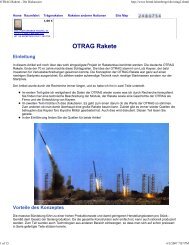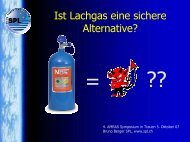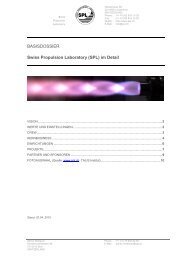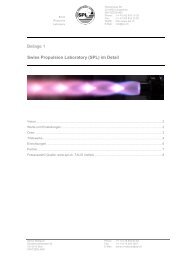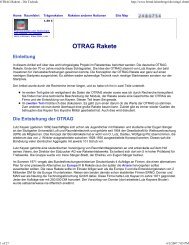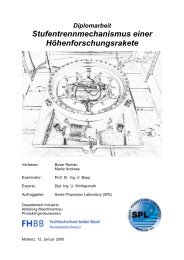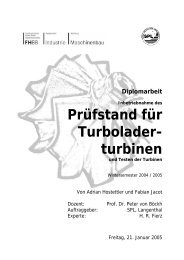Create successful ePaper yourself
Turn your PDF publications into a flip-book with our unique Google optimized e-Paper software.
have had a payload of 10 tons in a 200 km high circular orbit. The takeoff weight would<br />
be 978 tons.<br />
Assembly of a module<br />
Level 1 Level 2 Level 3<br />
Engines 6 * 36 = 216 36 36<br />
16 245 kN thrust 2008 kN 1035 kN<br />
Length 22 m 13.9 m 8.1 M<br />
Diameter 2.54 m 2.54 m 2.54 m<br />
Take Off Weight (estimated) 831500 kg 94900 kg 51 100<br />
Empty weight (estimated) 76800 kg 11900 kg 9700 kg<br />
Burn time 113 seconds 112 seconds 112 seconds<br />
specific impulse (estimated) 2433 m / s 2709 m / s 2800 m / s<br />
Later Lutz Kayser is the concept of a large tank and come off as well as the use of<br />
individual tubes tanks. The reason is mainly the flexibility, because you can combine<br />
virtually any number of units and can adapt the missile payload. Technically, of course, a<br />
large tank is much easier because the surface is smaller, but went to the <strong>OTRAG</strong> rocket it<br />
is not the best technically but commercially best solution. When <strong>OTRAG</strong> plays, of<br />
course, another point important: How much does the installation for the production? A<br />
plant which produces large tank is also big and expensive and thus increase the<br />
development costs, though perhaps later, the production costs are lower.<br />
Many innovative concepts were pursued initially Kayser phased out. So should the tanks<br />
are manufactured in the spiral welding process. It then went on to "normal" deep drawn<br />
steel tubes. Also, different size modules, different engine types and a start of a 20,000<br />
tons ship was not pursued. (Considered as an alternative, after being expelled from<br />
Zaire). Over time the module is simpler and more uniform.<br />
On with the engines, there was an evolution. It was essentially in the early foregone blend<br />
Diesel / nitric acid (which can vary in test launch has by something other hydrocarbons<br />
(kerosene, JP-1) or nitrogen oxides (nitric acid is nothing more than an aqueous nitrous<br />
oxide solution) tested. Was at the performance however, it is permanently downhill<br />
towards lower drawers. Of the 75 kN which one 1974 approach instead, out of 25 kN in<br />
the 80 s. Again, the development and production costs involved. The higher the boost the<br />
more difficult the use of ablation for the cooling of combustion chamber and nozzle.<br />
The first rocket was launched in Zaire, still had conventional aerodynamic fins. 1979, has<br />
tubular fins used for stabilization. There was no further change it in the length of the<br />
modules. In the plans in the 70 years for smaller payloads still versions of 12 m and 18 m<br />
long tanks were provided. Subsequent plans continued due to the lower full / empty mass<br />
ratio to a uniform height of 24 m for the tanks.<br />
Leased premises of the policy <strong>OTRAG</strong>Die<br />
Pretty soon got the <strong>OTRAG</strong> together the money for the development and could go even 2<br />
years after the founding of the planning of a start. The most important person in the



